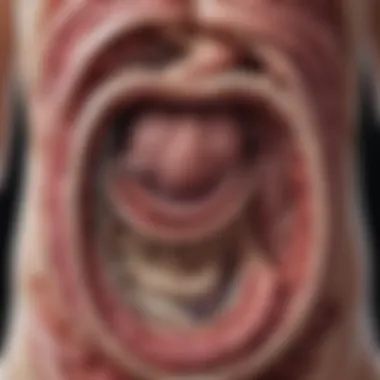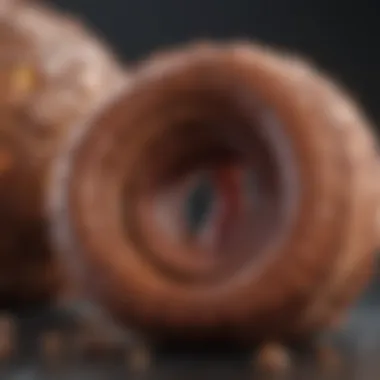Understanding Partially Obstructed Bowel Treatment


Intro
Partially obstructed bowel conditions can significantly impact an individual’s health. Understanding the nuances surrounding this medical issue is paramount for effective treatment and management. This section will explore the key aspects that contribute to partial bowel obstructions, discussing their causes, diagnostic procedures, and available treatment options. It aims to arm readers with the knowledge necessary to navigate the complexities of this condition.
Causes of Partial Bowel Obstruction
Partial bowel obstruction can arise from different factors, each contributing to the hindrance of normal bowel function. Some common causes include:
- Adhesions: Scar tissue that forms after surgery may lead to areas where the intestines become pinched or blocked.
- Hernias: A hernia occurs when an internal organ pushes through a weak spot in the surrounding muscle or tissue.
- Tumors: Both benign and malignant tumors can obstruct normal bowel movement by physically blocking the intestines.
- Inflammatory bowel disease: Conditions such as Crohn's disease can lead to swelling and strictures, resulting in partial obstruction.
Diagnostic Procedures
Accurate diagnosis is crucial for formulating appropriate treatment plans. Healthcare professionals typically employ a combination of the following diagnostic methods:
- Imaging Tests: Techniques like X-rays, Ultrasounds, or CT scans can reveal the location and cause of obstructions.
- Endoscopy: This method allows doctors to visualize the intestinal tract and sometimes even treat the obstruction during the procedure.
- Physical Examination: Physicians may palpate the abdomen to assess any unusual masses or areas of tenderness.
Treatment Options
Treating a partially obstructed bowel depends on the obstruction's cause and severity. Common treatment strategies include:
- Nonsurgical Interventions: In some instances, bowel rest and hydration may suffice. Medication can help manage underlying causes like inflammation.
- Endoscopic Techniques: Minimally invasive techniques can relieve obstructions or remove growths that are causing the blockage.
- Surgery: In more severe cases, surgical intervention may be necessary to remove obstructions or repair damaged parts of the bowel.
Recognizing the signs and symptoms of bowel obstruction early can lead to more favorable outcomes. Immediate medical attention is crucial.
Preventive Measures
While not all cases of partial obstruction can be prevented, certain strategies can mitigate risks. Consider the following preventive measures:
- Regular Check-ups: Routine visits with a healthcare provider can help identify early signs of bowel problems.
- Healthy Diet: Incorporating fiber-rich foods can promote regular bowel movements and decrease the risk of obstructions.
- Knowledge of Symptoms: Being aware of symptoms such as abdominal pain, vomiting, and changes in bowel habits allows for timely action.
Culmination
Understanding partially obstructed bowel conditions is critical for informed decision-making regarding health management. Acknowledging potential causes and available treatments can enhance patient outcomes, emphasizing the need for professional medical guidance. By integrating knowledge about preventive strategies into daily life, individuals can better protect themselves against the complications of bowel obstructions.
Prelude to Partially Obstructed Bowel
Understanding the dynamics of a partially obstructed bowel is imperative for both medical professionals and individuals involved in their care. This topic merges clinical knowledge with practical insights, bridging the gap between symptoms a patient may experience and the underlying causes that lead to bowel obstruction. Such obstruction can manifest in various ways, influencing not just the physical health of an individual but also their emotional and mental well-being. Therefore, a comprehensive grasp of this issue is not just beneficial but necessary.
Definition and Overview
A partially obstructed bowel refers to a condition where the intestines are not fully blocked but experience a significant reduction in the flow of contents. This can affect nutrient absorption and waste elimination. The obstruction can arise from multiple causes, ranging from adhesions and tumors to less common factors like volvulus or intussusception. This complexity necessitates awareness among individuals and caretakers about potential signs and symptoms, as early intervention can alleviate complications and enhance overall treatment outcomes.
Epidemiology of Bowel Obstruction
The prevalence of bowel obstruction is significant across various populations. While accurate statistics can vary, it is noted that bowel obstructions can occur in approximately 1 in 1,000 individuals annually. The incidence tends to be higher in specific groups, such as older adults or individuals with chronic intestinal conditions. Factors like previous abdominal surgeries increase the risk of obstruction due to the formation of scar tissue known as adhesions. Additionally, awareness of demographic variations helps tailor treatment and prevention strategies effectively.
Understanding these epidemiological data points is essential in framing discussions about the condition's impact at community and health system levels. By grasping the nuances of how and why these obstructions occur, one can better appreciate the implementation of treatment protocols designed to address both immediate medical needs and long-term health strategies.
Causes of Partial Bowel Obstruction
Understanding the causes of partial bowel obstruction is vital for effective treatment and management of the condition. Bowel obstruction can lead to serious complications, including bowel necrosis and perforation. Therefore, identifying the underlying causes helps in tailoring appropriate interventions. This section divides the causes into two main categories: mechanical and non-mechanical. Each type presents unique challenges and requires different diagnostic and therapeutic approaches.
Mechanical Causes
Mechanical causes refer to physical blockages in the bowel, significantly affecting its function. These can arise from a variety of conditions, including:


- Adhesions: Scar tissue from previous surgeries may adhere to the intestines and create a blockage.
- Hernias: A hernia occurs when an organ pushes through an opening in the muscle or tissue. This can restrict blood flow and cause obstructions.
- Tumors: Benign or malignant growths in or near the intestine can compress or invade the bowel, leading to obstruction.
- Intussusception: In this condition, a part of the intestine folds into another segment, effectively narrowing the passage and causing a blockage.
- Volvulus: This refers to the twisting of the intestine, which obstructs the blood supply and can result in necrosis if not treated swiftly.
These mechanical factors necessitate mechanical interventions, often requiring imaging techniques for accurate diagnosis. Surgical options may be required, depending on severity and the specific cause of the obstruction.
Non-mechanical Causes
Non-mechanical causes, on the other hand, involve disruptions in the bowel's motility rather than physical obstructions. Common non-mechanical causes include:
- Ileus: This is a temporary cessation of bowel movement often seen after surgery or in response to medications.
- Neurological Disorders: Conditions like Parkinson's disease or multiple sclerosis can affect nerve impulses, disrupting normal bowel function.
- Electrolyte Imbalances: Low levels of essential electrolytes, like potassium, can impair the muscle contractions of the bowel, leading to a functional obstruction.
- Infections: Severe infections, such as gastroenteritis, can result in intestinal paralysis, causing non-mechanical obstruction.
Identifying non-mechanical causes often requires a different diagnostic approach compared to mechanical causes. Treatment can also vary and may include medications or changes in dietary management.
Understanding both mechanical and non-mechanical causes is essential for developing an effective treatment plan. Addressing the right cause can minimize complications and promote a faster recovery.
Symptoms and Diagnosis
In understanding partially obstructed bowel conditions, recognizing the symptoms and diagnostic methodologies is crucial. Symptoms provide initial insights to alert both pet owners and veterinarians to possible issues, guiding timely intervention. Accurate diagnosis through various techniques not only helps in confirming the condition but also aids in distinguishing between partial and complete obstructions. This accuracy is vital in determining the most appropriate treatment course, minimizing risks through early detection. Thus, awareness of symptoms and diagnostic procedures is integral for effective management of partial bowel obstruction in pets.
Common Symptoms of Partial Obstruction
Pet owners might observe a range of symptoms when a pet experiences a partial bowel obstruction. These can vary, but some of the most common include:
- Abdominal pain: Pets may exhibit signs of discomfort, such as whining or restlessness. They might also adopt unusual postures, such as lying in a curled position.
- Vomiting: Repeated vomiting, particularly after eating, can be a clear indicator. Vomit may contain undigested food or bile, depending on the level of obstruction.
- Inconsistent bowel movements: Changes in stool frequency and consistency are common. This can include diarrhea or the presence of blood, signaling a more severe issue.
- Loss of appetite: Affected pets often show no interest in food, which can lead to weight loss over time.
Recognizing these signs early can significantly impact the outcomes of treatment.
Diagnostic Imaging Techniques
Once symptoms are noted, veterinarians rely on diagnostic imaging techniques to visualize the condition of the bowel. The following methods are frequently employed:
- X-rays: This basic imaging technique can reveal fluid levels and gas patterns in the intestines, indicating possible obstructions.
- Ultrasound: Provides real-time images of the abdomen, allowing for a detailed assessment of the intestinal wall and surrounding tissues.
- CT scans: This advanced imaging technique offers a comprehensive view, identifying the specific location and cause of the obstruction, especially in complex cases.
Each of these imaging techniques has its own strengths, which makes them valuable when diagnosing partial bowel obstruction.
Laboratory Tests in Diagnosis
In tandem with imaging, laboratory tests can also contribute to the diagnostic process. Key tests may include:
- Blood tests: These can reveal electrolyte imbalances or signs of infection, which are essential in assessing the overall health of the pet.
- Urinalysis: Helps determine if the kidneys are functioning properly, which can be affected during severe gastrointestinal distress.
- Fecal examination: This test may identify parasites or other abnormalities in the intestines, which can lead to obstructions.
Utilizing a combination of imaging techniques and laboratory tests allows veterinarians to form a complete clinical picture, guiding effective treatment options.
Recognizing symptoms early and understanding diagnostic measures can dramatically affect outcomes in pets affected by bowel obstructions.
Treatment Strategies for Partially Obstructed Bowel
The topic of treatment strategies for partially obstructed bowel is critical for understanding how to address this condition effectively. Different approaches may be adopted based on the severity of the obstruction and the individual circumstances of the patient. The ultimate goal is to alleviate symptoms, restore normal bowel function, and prevent further complications. By exploring both conservative management and surgical interventions, this section aims to provide a thorough overview of the available treatment options, their benefits, and considerations.
Conservative Management
Conservative management refers to non-surgical methods employed to treat partially obstructed bowel. These strategies often have a significant role in the initial management of the condition, particularly for patients with mild symptoms.
Fluid Therapy
Fluid therapy is a fundamental component of conservative management for bowel obstruction. This approach ensures that patients remain hydrated, especially if they are unable to consume oral fluids. The key characteristic of fluid therapy is its ability to replenish lost fluids and electrolytes, which is crucial in maintaining bodily function. Fluid therapy can support overall health and potentially promote the passage of stool through the intestine.
One unique feature of fluid therapy is the use of intravenous (IV) fluids in more severe cases, which can provide immediate support when oral intake is not feasible. The advantages of this treatment include improved hydration status and reduced risk of serious complications, such as renal failure. However, close monitoring is essential to avoid fluid overload, which can exacerbate the condition.


Medications for Pain Management
Pain management is vital in alleviating the discomfort associated with a partially obstructed bowel. Specific medications, such as analgesics, can help manage pain levels effectively. The key characteristic of medications for pain management is their ability to address pain without worsening the obstruction.
Many medications, such as acetaminophen, are known for their efficacy in managing mild to moderate pain. The unique feature of using pain management medications is that they can greatly improve patient comfort, facilitating better observation and monitoring of symptoms. However, it is crucial to avoid opioid medications as they can slow bowel motility, potentially worsening the obstruction.
Monitoring and Observation
Monitoring and observation are integral components of conservative management. Continuous assessment of the patient's condition helps guide treatment decisions and determine the need for further interventions. The key characteristic of this approach is its non-invasive nature, allowing for careful supervision without immediate surgical intervention.
The unique feature here is that regular monitoring enables healthcare professionals to detect any signs of deterioration promptly. This strategy has the advantage of allowing patients to potentially recover from the obstruction without needing surgery. However, it requires careful and consistent monitoring to ensure no complications arise, necessitating readiness for potential surgical intervention if symptoms worsen.
Surgical Interventions
In cases where conservative management is not effective or the obstruction is severe, surgical interventions may be necessary. Surgical methods can provide a definitive solution to the issue.
Laparoscopic Techniques
Laparoscopic techniques are minimally invasive surgical methods used to treat partially obstructed bowel. One primary advantage of this approach is that it can result in less post-operative pain and quicker recovery compared to traditional open surgery. The key characteristic is the small incisions used, which can reduce trauma to surrounding tissues.
The unique feature of laparoscopic surgery is the use of specialized instruments and cameras, which allow surgeons to visualize and operate on the bowel with greater precision. This technique's benefits include a shorter hospital stay, less scarring, and a quicker return to normal activities. However, not all cases are suitable for laparoscopic intervention, and certain anatomical and pathological factors may necessitate open surgery instead.
Open Surgery Approaches
Open surgery remains a conventional option for patients with significant bowel obstructions that cannot be addressed through laparoscopic means. The key characteristic of open surgery is the larger incision, which allows for more comprehensive access to the abdominal cavity. This method is beneficial for more complex cases, where the extent of the obstruction requires thorough examination and correction of the underlying issue.
The unique feature of open surgery is its ability to enable surgeons to perform extensive procedures, such as resection or bowel repair. While the advantages include a direct view of the abdominal organs and potentially addressing multiple issues in one operation, disadvantages involve longer recovery times and increased post-operative pain.
Post-Treatment Considerations
Post-treatment considerations play a vital role in ensuring the recovery and long-term health of patients with partially obstructed bowel conditions. After undergoing treatment, whether conservative or surgical, it is crucial to monitor the individual’s recovery process and be aware of any potential complications that may arise. This section delves into the recovery process, possible complications, and the importance of follow-up care, emphasizing their significance in promoting a positive outcome.
Recovery Process and Monitoring
The recovery process after treatment for partially obstructed bowel varies depending on the type of management received. Generally, patients are monitored closely in the immediate aftermath of treatment. This monitoring includes watching for signs of bowel function returning, such as passing gas or having bowel movements. Health professionals typically assess the patient's overall condition, including pain levels and signs of infection.
Follow-up assessments often involve clinical evaluations and imaging tests to ensure that the obstruction has been resolved. During this time, it is essential that patients adhere to any prescribed recovery plans, including dietary adjustments and medication schedules. Close observation can lead to early detection of complications, which can be critical for successful recovery.
Potential Complications After Treatment
While treatment aims to alleviate the obstruction, potential complications can arise. Some common ones include:
- Re-obstruction: This may occur if underlying conditions or factors that caused the initial obstruction are not resolved.
- Infection: Surgeons can create a risk for infections post-operation, particularly if the bowel was perforated.
- Adhesions: Scar tissue formation can lead to future complications, including further obstructions.
- Electrolyte Imbalance: Especially after significant fluid loss due to vomiting or diarrhea, it may be necessary to monitor and manage electrolyte levels.
Patients must be aware of these risks and report any concerning symptoms, such as increased pain, fever, or changes in bowel habits, to their healthcare provider quickly.
Follow-Up Care Requirements
Follow-up care is integral to ensure that patients continue to recover well after treatment. Regular appointments with healthcare providers help track the recovery progress and allow for timely intervention if complications arise.
During follow-up visits, healthcare professionals may:
- Evaluate recovery through discussions about diet, bowel movements, and overall health.
- Conduct physical examinations to check for persistent or new symptoms.
- Order additional imaging studies if needed to confirm the resolution of the obstruction.
Education on maintaining a healthy lifestyle, including dietary changes and hydration, can be part of follow-up care. Understanding how to manage one’s health post-treatment can greatly influence long-term outcomes.


"Effective post-treatment care is just as crucial as the initial treatment itself. It defines the path toward lasting recovery."
In summary, addressing post-treatment considerations provides a structured approach to recovery. Monitoring, awareness of complications, and diligent follow-up care are foundational to achieving optimal outcomes for individuals affected by partially obstructed bowel conditions.
Preventive Measures and Lifestyle Adjustments
Understanding preventive measures and lifestyle adjustments is crucial in managing partial bowel obstruction. These strategies not only help in reducing the risk of obstruction but also improve overall digestive health. A proactive approach can lead to fewer complications and a better quality of life for individuals susceptible to this condition. By incorporating certain practices into daily routines, affected individuals may mitigate symptoms and avoid serious health issues in the future.
Dietary Considerations
Diet plays a significant role in preventing bowel obstructions. The right food choices can ensure proper digestion and promote healthy bowel movements. A high-fiber diet is essential as it aids in maintaining regularity. Foods such as fruits, vegetables, whole grains, and legumes contribute beneficial fiber that supports digestion.
It is also important to avoid foods that can lead to constipation. Such foods include those high in fat and low in fiber, like processed snacks and fast food. Additionally, individuals should be cautious with certain foods that could form gas or lead to bloating. Things like beans, carbonated drinks, and certain cruciferous vegetables might contribute to discomfort.
Keeping a food journal can help track how different foods affect one’s digestive health. This knowledge empowers individuals to make choices that foster nutrient absorption while minimizing risks of obstruction.
Emphasis on Hydration
Hydration is another essential component in preventing bowel obstruction. Adequate fluid intake aids in digestion and ensures that the body can process food efficiently. Water helps to soften stool, making it easier to pass and thus reducing the likelihood of constipation, which is a common precursor to blockage.
Aim for at least 8 to 10 cups of water daily, adjusting for factors like climate and physical activity. In addition to water, fluids from fruits, vegetables, and herbal teas can contribute to hydration. It is advisable to limit intake of sugary beverages and caffeine, as they can have a dehydrating effect and exacerbate digestive issues.
Staying well-hydrated is fundamental to maintaining a healthy digestive system. Without sufficient fluid, the intestines cannot function optimally, leading to potential complications.
Psychosocial Impact of Bowel Obstruction
The psychosocial impact of bowel obstruction is often underestimated in clinical discussions. It encompasses not only the physical strain that the condition places on the individual but also the profound emotional and mental health effects it can have. Patients face various challenges that extend beyond mere bodily symptoms. Understanding these factors is crucial for comprehensive patient care.
Emotional and Mental Health Effects
Patients with partially obstructed bowel conditions frequently experience a range of emotional responses. Fear often takes center stage, stemming from uncertainties regarding the health implications. The anxiety about possible complications, the need for surgery, or long-term health outcomes can be overwhelming. This apprehension can lead to feelings of helplessness or despair as patients grapple with their condition.
Moreover, depression can emerge as a significant concern. Research indicates that gastrointestinal disorders, including bowel obstructive issues, can exacerbate feelings of isolation and sadness. The daily constraints imposed by the condition—such as dietary restrictions or frequent medical visits—can disrupt personal, social, and professional lives. In many cases, individuals may withdraw from social activities, leading to loneliness.
Coping strategies play a crucial role in managing these emotional responses. Support from family and friends is essential. This can include simple acts of understanding or accompanying patients to medical appointments. Professional counseling may also be beneficial for those struggling to manage their emotional health. It's important for healthcare providers to recognize these challenges and encourage open conversations about mental health.
"Addressing the emotional health of patients is as important as treating their physical symptoms."
Support Systems and Resources Available
Developing a robust support system is vital for individuals suffering from bowel obstruction. Support can come from various sources and include an array of resources designed to help patients navigate their challenges.
- Family and Friends: Close relationships remain one of the strongest forms of support. They can provide practical assistance and emotional reassurance. Just knowing someone is present can alleviate some feelings of isolation.
- Support Groups: Forums and groups specifically aimed at individuals dealing with bowel-related issues can offer collective understanding and shared experiences. These can be found both in-person and online, allowing for flexibility and broader outreach.
- Mental Health Professionals: Engaging with therapists or counselors can provide the tools necessary to cope with anxiety and depression. Cognitive Behavioral Therapy (CBT) has shown effectiveness in aiding patients to alter negative thought patterns.
- Educational Resources: Websites such as Wikipedia, Britannica, and community platforms like Reddit can provide valuable information about bowel obstruction and its emotional impact. These platforms can offer insights, coping strategies, and a community of individuals facing similar challenges.
The End and Future Directions
In concluding this analysis of partially obstructed bowel conditions, it is essential to recognize the multifaceted nature of this medical issue. Understanding the complexities surrounding treatment options can lead to better management and outcomes for affected individuals. The discussions in this article underscore not only the necessity of timely medical intervention but also the importance of follow-up care.
The future directions in the treatment and management of partially obstructed bowel should focus on enhancing diagnostic techniques, optimizing conservative management approaches, and refining surgical interventions. By adopting a more patient-centered care model, healthcare professionals can tailor treatment strategies that meet the unique needs of each patient.
In summary, addressing the implications of partially obstructed bowel conditions effectively requires continuous learning and adaptation to new knowledge and technologies.
Summary of Key Points
- Definition and Importance: Understanding bowel obstruction's various forms and impacts is crucial for effective treatment.
- Variety of Causes: Both mechanical and non-mechanical factors contribute to partial bowel obstructions, necessitating thorough investigation.
- Symptom Recognition: Early identification of symptoms can facilitate timely diagnosis and treatment.
- Diverse Treatment Strategies: Options range from conservative management to advanced surgical techniques, each with specific risks and benefits.
- Post-Treatment Recovery: Close monitoring and follow-up care are vital to prevent complications and ensure successful recovery.
- Preventive Measures: Lifestyle adjustments, including diet and hydration, play a significant role in managing and preventing recurrences.
Emerging Trends in Treatment
Advancements in the approach to treating partially obstructed bowel are continually evolving, marking a shift towards more innovative solutions. Current trends include:
- Minimally Invasive Techniques: Laparoscopic surgery is gaining favor due to its potential for shorter recovery times and reduced post-operative complications.
- Integrative Approaches: Combining conventional medicine with alternative therapies to support overall well-being during recovery is becoming more common.
- Telemedicine: The integration of telehealth provides patients with greater access to consultations and follow-up care remotely.
- Research and Education: Ongoing studies into the underlying causes of bowel obstruction are essential for developing better prevention and treatment strategies.
Overall, staying informed about these emerging trends is vital for both healthcare professionals and patients in pursuit of optimizing treatment outcomes.



